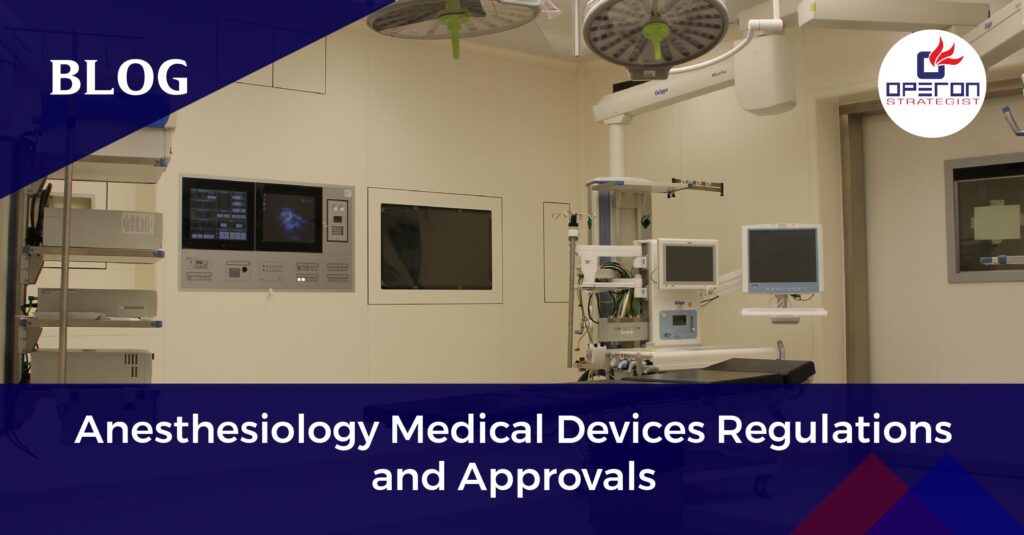Anesthesiology medical devices are critical components of patient care in surgical procedures and medical treatments. These devices help to control pain, manage breathing and circulation, and monitor vital signs, ensuring that patients remain safe and comfortable throughout their procedures. In order to ensure the safety and efficacy of these devices, they are subject to a range of regulatory requirements and approvals.
Regulations and Approvals of Anesthesiology Medical Devices:
CDSCO– In India, medical devices used in anesthesiology, such as anesthesia machines and ventilators, must be approved by the Central Drugs Standard Control Organization (CDSCO) before they can be used. Approval is granted after evidence of safety, quality and effectiveness is provided by the manufacturer through clinical trials and testing. Manufacturers must also regularly monitor the devices and report any adverse events to the CDSCO. The approval process helps ensure patients receive safe and effective care during anesthesia procedures.
FDA- In the US, medical devices used in anesthesiology, such as anesthesia machines and ventilators, are regulated by the Food and Drug Administration (FDA). The FDA reviews and approves these devices based on their safety, effectiveness and quality before they can be marketed and used in the country. Regular monitoring and reporting of adverse events are also required. The FDA regulations help ensure that patients receive safe and effective care during anesthesia procedures.
EU MDR- In the European Union (EU) medical devices used in anesthesiology, such as anesthesia machines and ventilators, are regulated by the Medical Device Regulations (MDR). The MDR requires manufacturers to prove the safety, effectiveness and quality of their devices through and testing before they can be marketed and used in the EU. The MDR also requires ongoing monitoring and reporting of adverse events. The regulations under the MDR help ensure that patients receive safe and effective care during anesthesia procedures in the EU.
Approvals for anesthesiology medical devices can take a significant amount of time, as the regulatory process is designed to ensure the safety and efficacy of these critical components of patient care. Manufacturers must be able to demonstrate that their devices are safe and effective, and that they meet the necessary regulatory standards, before they can be approved for use in the US market. In addition, regulatory approvals help to ensure the continued development of new and innovative anesthesiology medical devices, allowing manufacturers to bring cutting-edge technologies to market. These advances can help to improve patient outcomes, reduce the risk of complications, and improve the overall quality of patient care.
The Role of Approved Medical Devices:
Medical devices play crucial role in anesthesiology by ensuring patient safety and comfort during surgical procedures. These devices help monitor and control vital signs, such as blood pressure and heart rate, during surgery. Additionally, they assist in administering anesthesia and pain management. Approved medical devices are crucial in the field of anesthesiology because they are rigorously tested and have met the necessary safety and performance standards set by regulatory bodies. Anesthesia machines, monitoring devices, and intravenous pumps are the devices which provides to the healthcare with the information they need to make informed decisions about patient’s well-being during surgery. By using approved medical devices, anesthesiologists can ensure that they are delivering safe and effective care to their patients.
Market Size and Growth for Anesthesiology Medical Devices:
The market size for the manufacturing of anesthesiology medical devices is difficult to estimate precisely as it depends on multiple factors such as the type of device, the region, and the target customer segment. However, according to a report the global market for anesthesiology medical devices was valued at $8.6 billion in 2018 and is expected to grow at CAGR of 6.0% from 2019 to 2024, reaching $11.4 billion by 2024. The increasing demand for minimally invasive surgeries, advancements in medical technology, and the growing population are driving the growth of the market for anesthesiology medical devices manufacturing in India. By understanding the regulations and requirements of the manufacturing anesthesiology medical devices as well as the needs and the preferences of customers, manufacturers can bring innovative and effective products to the market that help improve patient care and outcomes.
Conclusion:
Anesthesiology medical devices are essential components of patient care in surgical procedures and medical treatments. By subjecting these devices to rigorous regulations and approvals, the FDA is able to ensure their safety and efficacy, and to provide patients and healthcare providers with the confidence the need when using these devices. The regulatory process is designed to support the development of new and innovative technologies, and to promote continuous improvement in the quality of patient care.
As medical device consultants, we provide guidance for various Certifications, regulatory services, and approvals. For more information please be connected to us and feel free to contact us.
- adminhttps://operonstrategist.com/author/admin-2/
- adminhttps://operonstrategist.com/author/admin-2/
- adminhttps://operonstrategist.com/author/admin-2/
- adminhttps://operonstrategist.com/author/admin-2/




